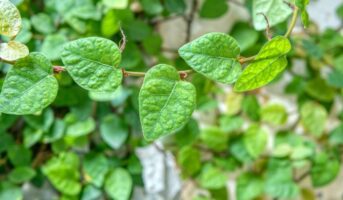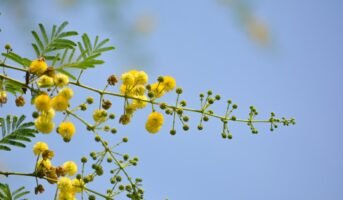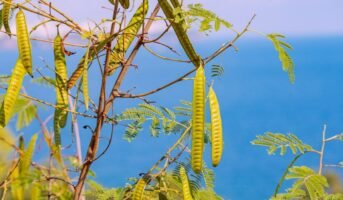Gular, known as Udumbara in Sanskrit, is the Indian fig variant. From the Ficus racemosa species, the tree offers various medicinal benefits. It is also revered in Indian mythology.
Gular tree: Quick facts
| Botanical name | Ficus racemosa |
| Kingdom | Plantae |
| Order | Rosales |
| Family | Moraceae |
| Genus | Ficus |
| Also known as | Cluster fig, Athipalam, Red river fig, Goolar, Udumbara, Umber and Dumri. |
| Height | 10 to 16 metres |
| Climate | Hot and humid climate |
| Sun Exposure | Full sun |
| Ideal temperature | 15 – 45 degrees Celsius |
| Soil type | Well-drained, moist soil |
| Soil pH | 5 to 8.3 |
Gular tree: Physical description
Gular is a lovely fig tree with a spreading canopy and a crooked trunk. It does not have aerial roots as a banyan does. Its most noticeable feature is the little clusters of red, hairy figs that emerge from this tree’s trunk. The fig, which is what people looking for the Gular flower should know, is a compartment that holds hundreds of blossoms.
One might be curious about the pollination process for these balled-up blossoms. Very tiny wasps creep through the hole for an excellent location to reproduce and fertilise the blooms (lay eggs). Fig trees are unable to reproduce by seed without the help of pollinators. In return, the blooms offer protection and food to the wasps’ offspring.
Gular tree: How to cultivate it?

Source: Pinterest
There is no evidence that this species is widely farmed. However, in its natural habitat, it has been utilised as a living fence post or as a support for other climbing plants. The wood is incredibly sturdy and long-lasting.
- Cuttings or seeds can be used to multiply it. Any time of the year, these seeds should be sown into a sandy, well-drained compost, thinly covered with sand or grit, and kept moist. Keep between 20 and 25 °C. Please be patient, as seeds can sometimes take 4 to 6 weeks to germinate, while some may take much longer. In places with milder climates, plant outside or in a sizable container.
- Ficus racemosa seedlings develop quickly and can bear flowers and fruits in their first year. Cuttings should be picked from new, healthy growth, and if maintained warm and wet, they will root easily.
- Once established, this plant has a strong drought tolerance, although regular watering during the fruiting season will increase the amount of fruit it produces. Even in hot areas, it can take moderate shade but prefers full sun.
Gular tree: Maintenance tips
Fertiliser
- Gular trees are not heavy feeders, so you do not need to bother about fertilising them, especially if you treated the soil at planting time with cow dung manure or vermicompost.
- Use a balanced liquid fertiliser, diluted to half its strength, once every 4-6 weeks to promote the growth of the Gular tree. Do this when the plant is young. Also, cease feeding the Gular tree in the winter.
Pests and diseases
- Although the Gular tree is resistant to pests, it may be vulnerable to thrips, whitefly scales, and spider mites in its early stages. For the majority of pests, insecticidal soap works well.
- Make sure not to overwater the plant when it is young in order to prevent common tree diseases.
Gular tree: Benefits

Source: Pinterest
- Benefit in cancer: Gular possesses potent anti-inflammatory and anti-cancer effects. The qualities of the juice obtained from this tree can aid us in eliminating cancer cells when used as a treatment. You are aware that this tree’s fruits can be eaten.
- Benefits for diabetes: The tree can reduce blood sugar levels. You could use a Gular tree bark decoction for this. Blood sugar levels may be lowered by Gular bark.
- Effective for regulating abnormal heartbeats: Magnesium is quite helpful for regulating erratic heartbeats. Muscular tension and oxidative damage can lead to an irregular heartbeat. Fruits of this tree contain significant levels of magnesium. This keeps your digestion in good shape and removes all of these symptoms.
Gular tree: Toxicity
- The principal irritant is latex sap, which is toxic to both humans and animals and is hazardous to the eyes and, to a lesser extent, the skin.
- The most frequent skin reaction to contact is dermatitis, though the mouth and eye irritation can be more painful.
- However, overall plant toxicity assessments place ficus in the lower range.
Cultural significance of Gular tree
The Gular tree is considered sacred and is associated with various deities in Hindu mythology, including Lord Krishna and Lord Shiva. As a result of this, various religious rituals and ceremonies are performed under this tree. Believers also tie sacred threads around the trunk of the tree to seek blessings and protection.
FAQs
Is the Gular fruit edible?
The fruits are nutrient-rich and edible. Gular fruits can help with menstruation, biliary, and urinary illnesses, as well as cooling and heart tonic conditions. Many ailments can be treated with fresh juice or the decoction of leaves.
Do flowers grow on Ficus racemosa?
The little clusters of red, hairy figs that emerge from this tree's trunk are its most noticeable feature. The fig is a compartment that holds hundreds of blossoms.
Housing News Desk is the news desk of leading online real estate portal, Housing.com. Housing News Desk focuses on a variety of topics such as real estate laws, taxes, current news, property trends, home loans, rentals, décor, green homes, home improvement, etc. The main objective of the news desk, is to cover the real estate sector from the perspective of providing information that is useful to the end-user.
Facebook: https://www.facebook.com/housing.com/
Twitter: https://twitter.com/Housing
Email: [email protected]











